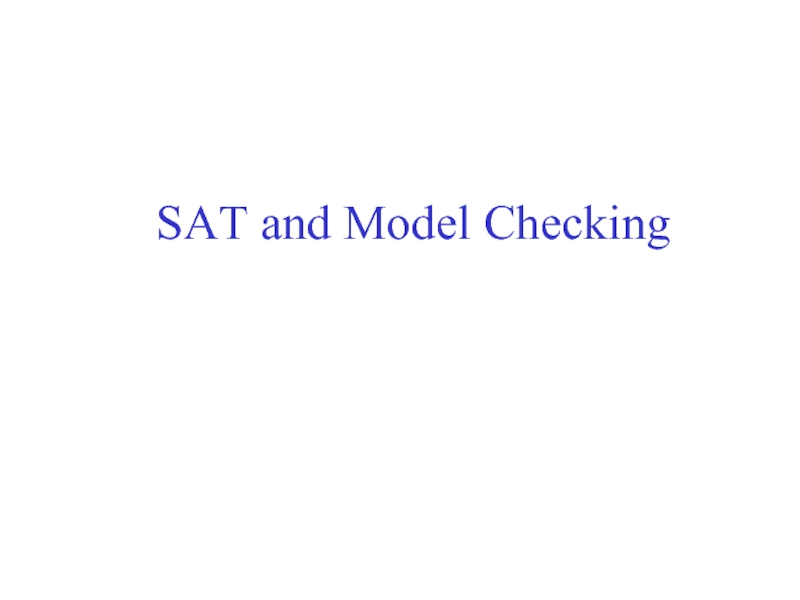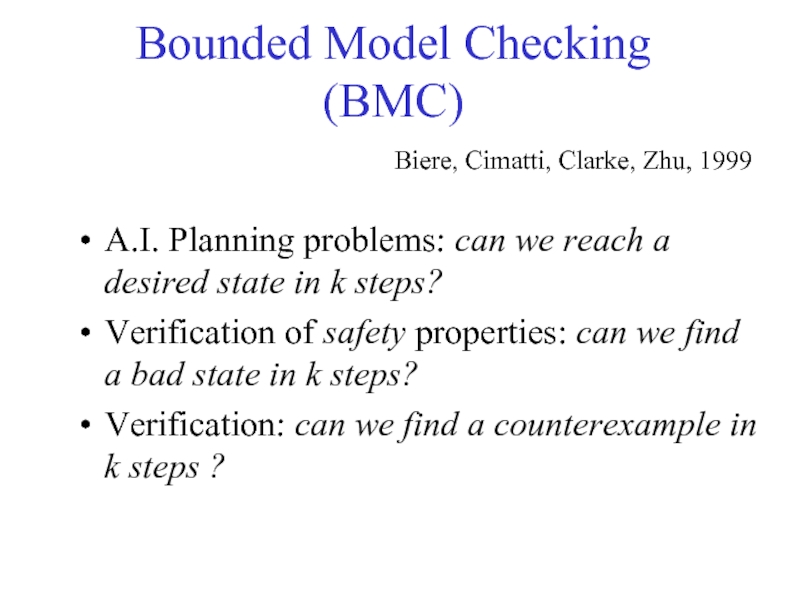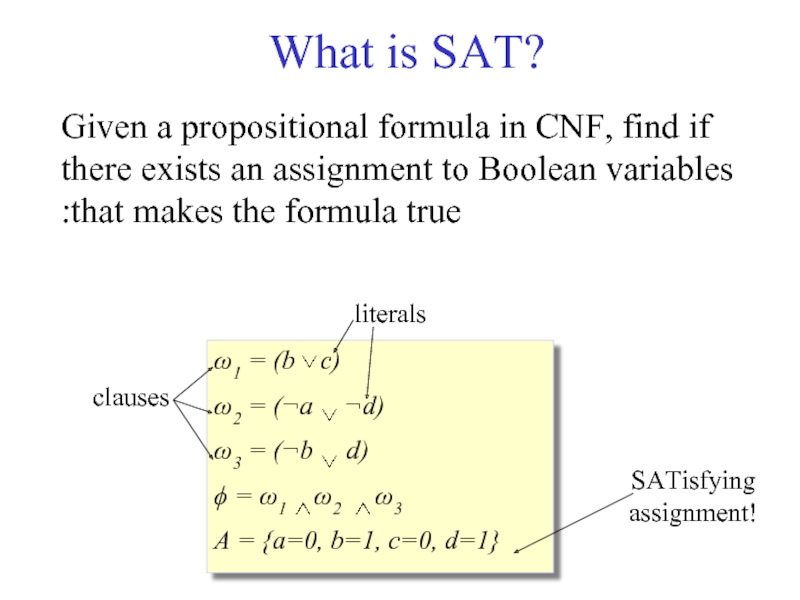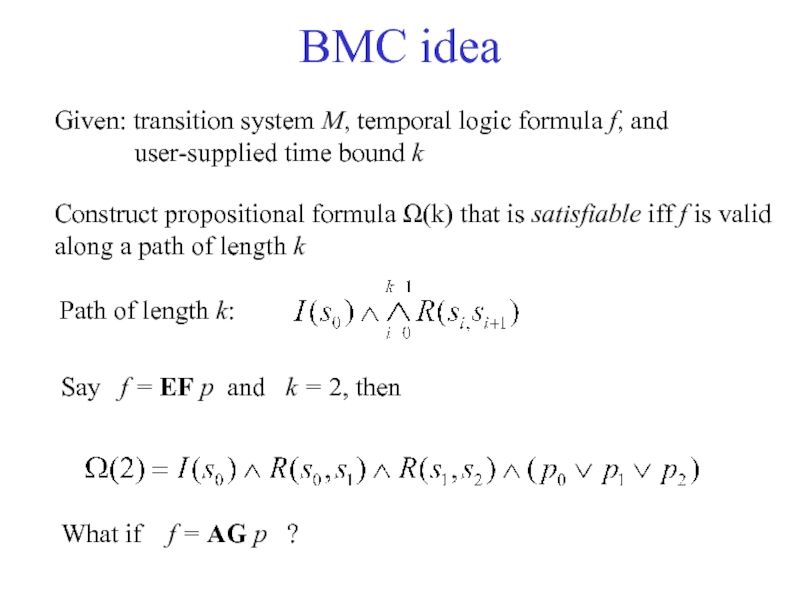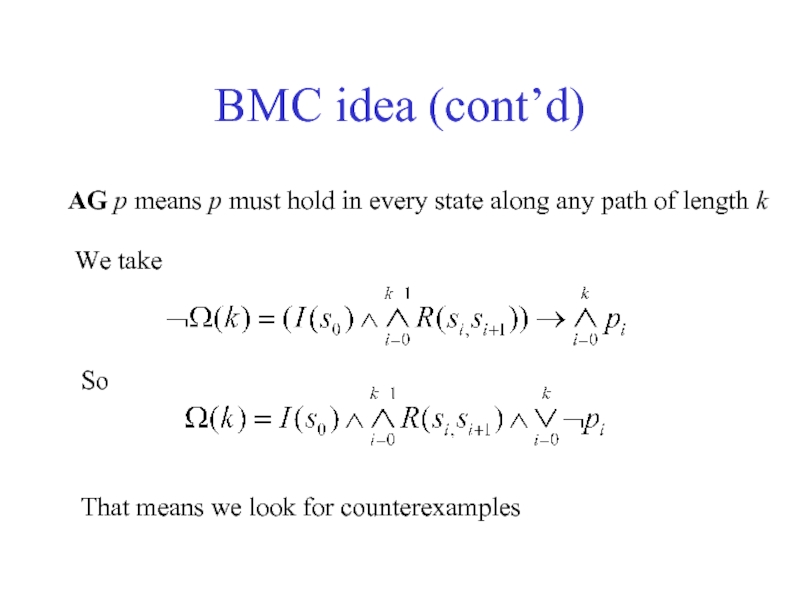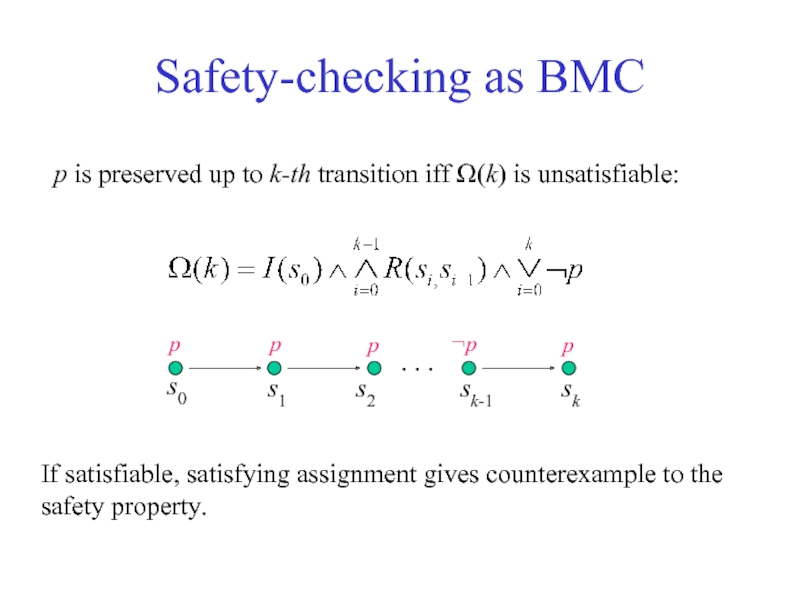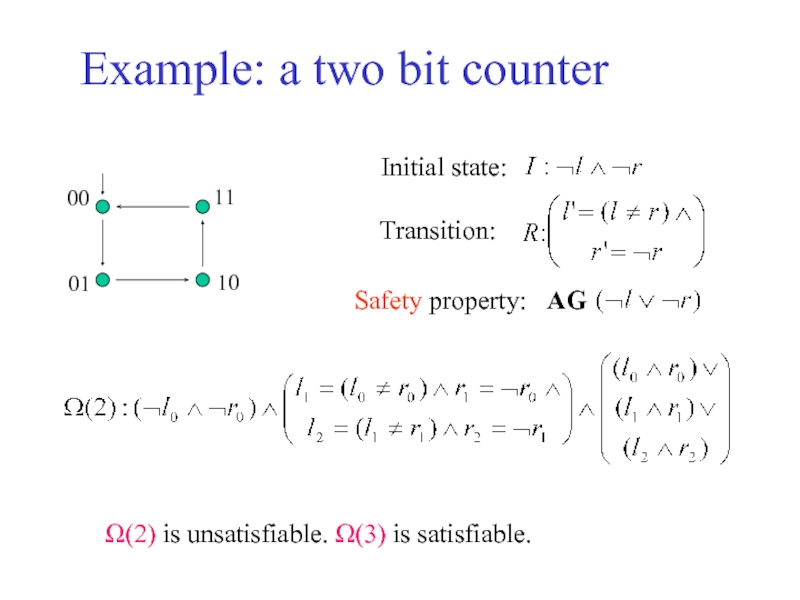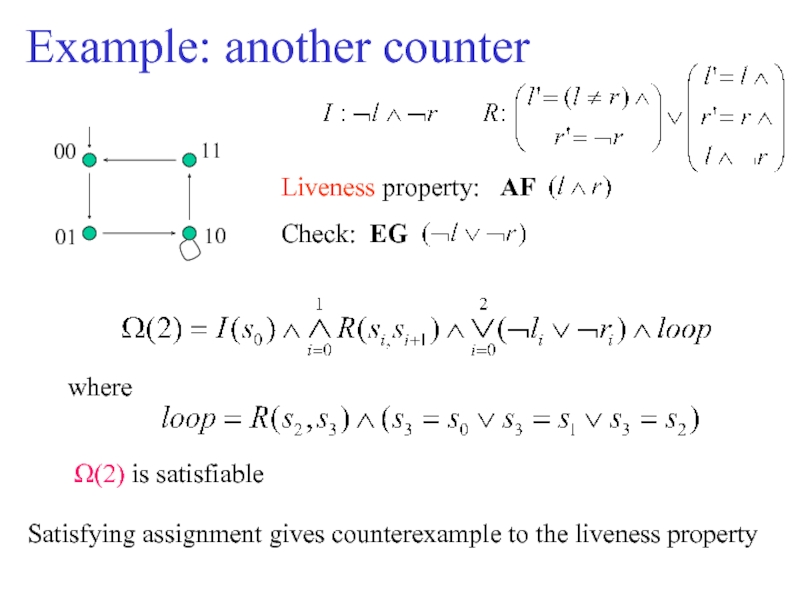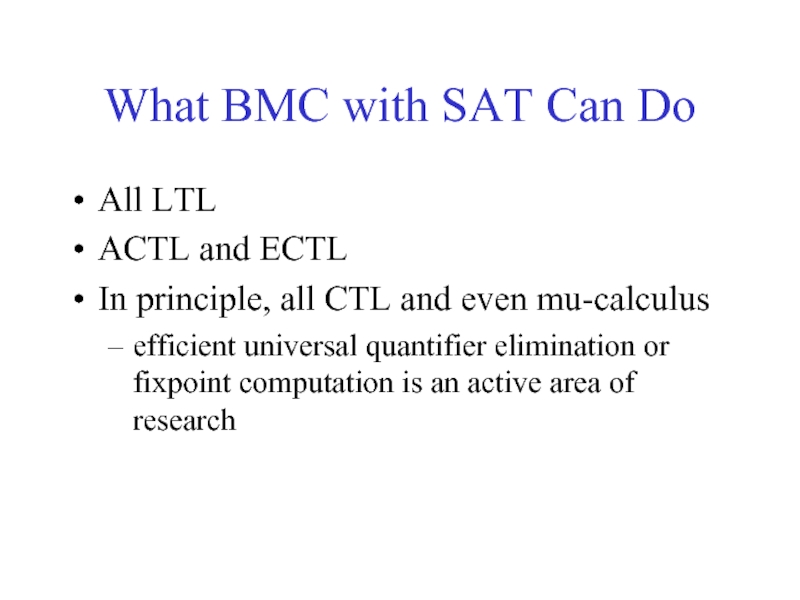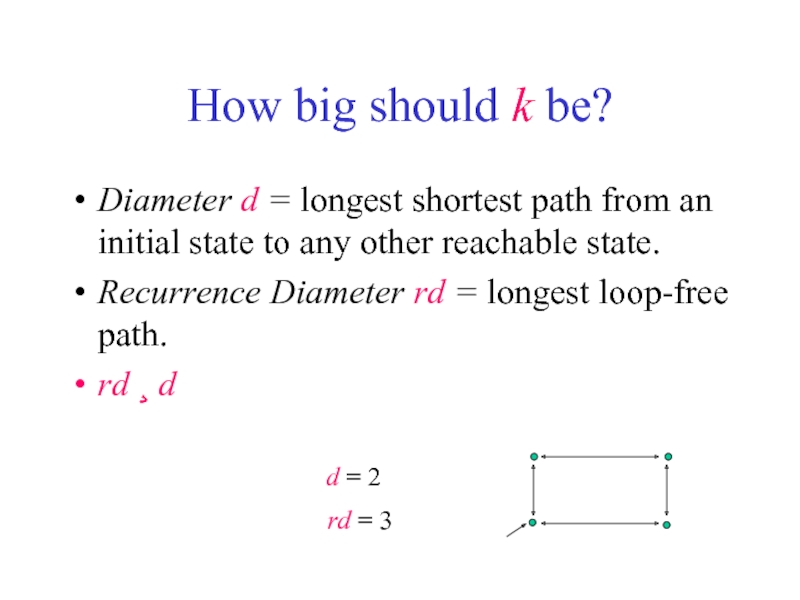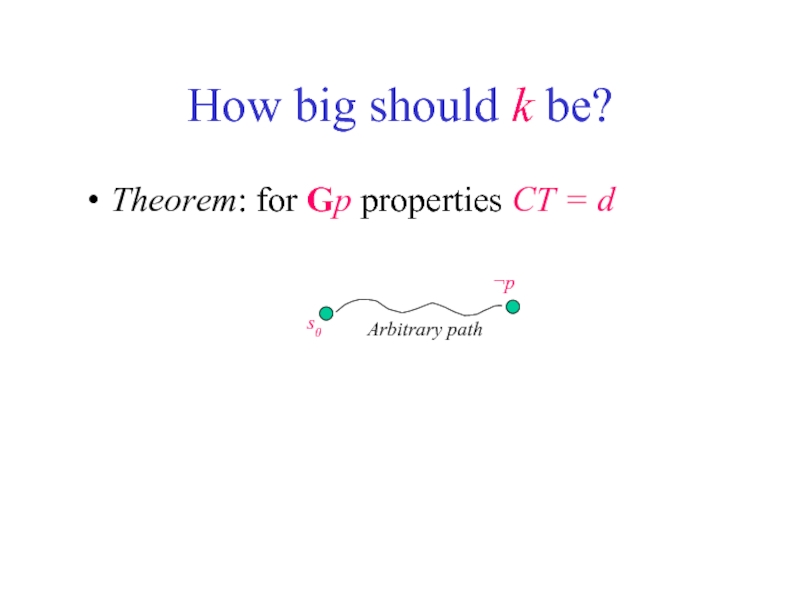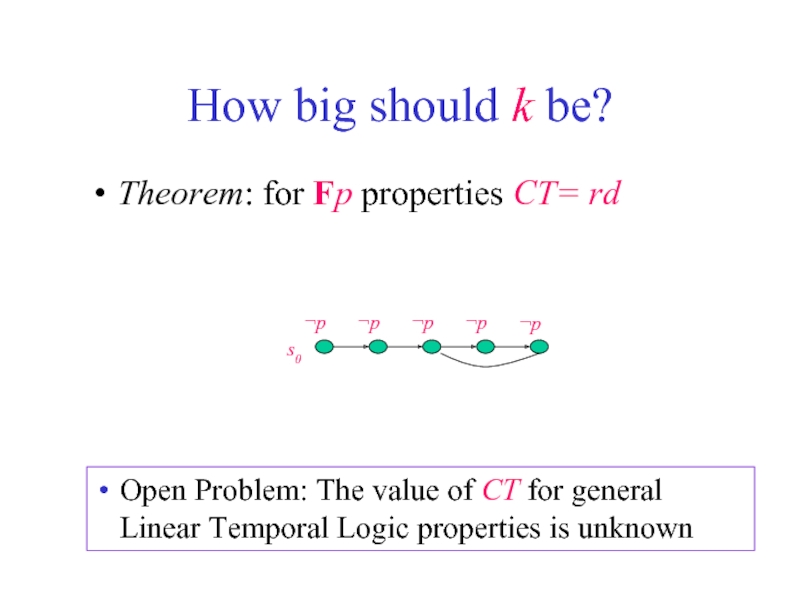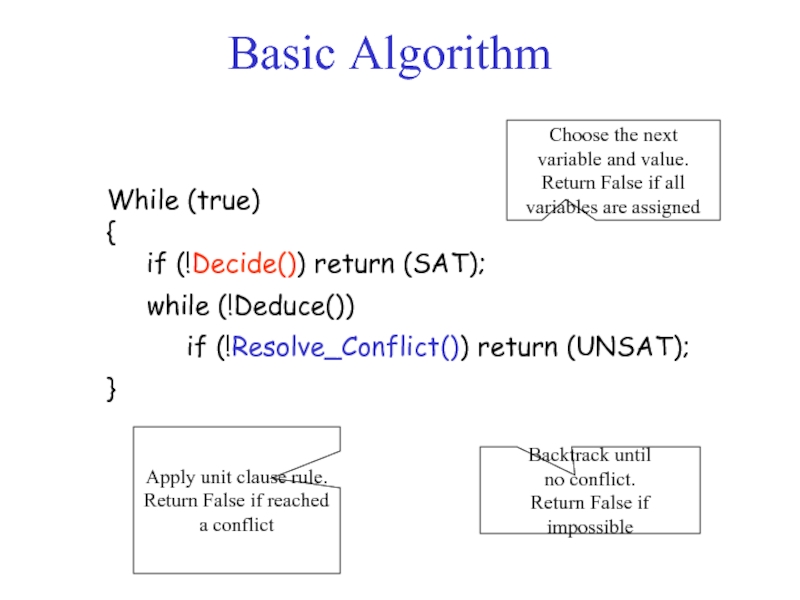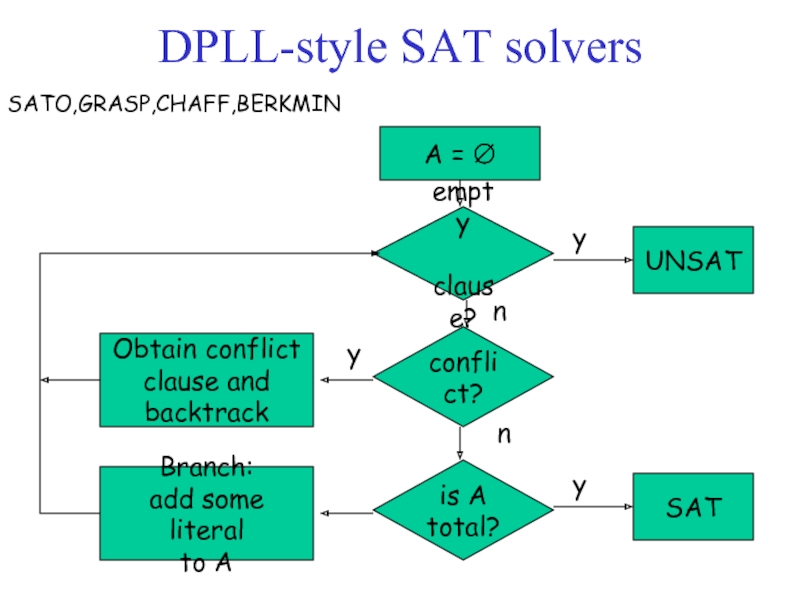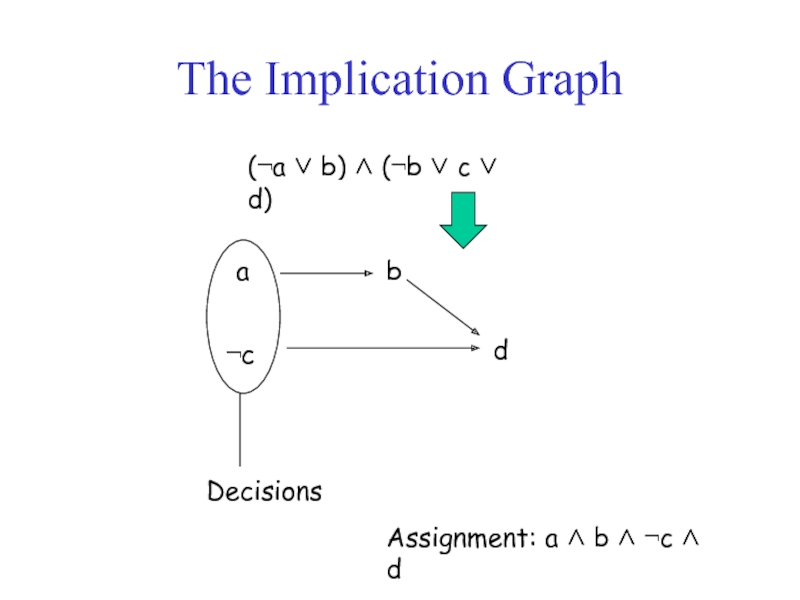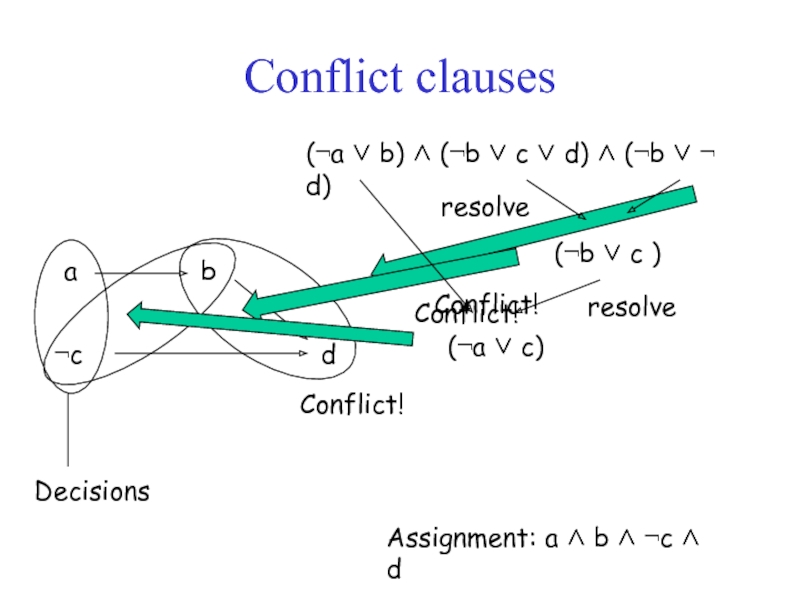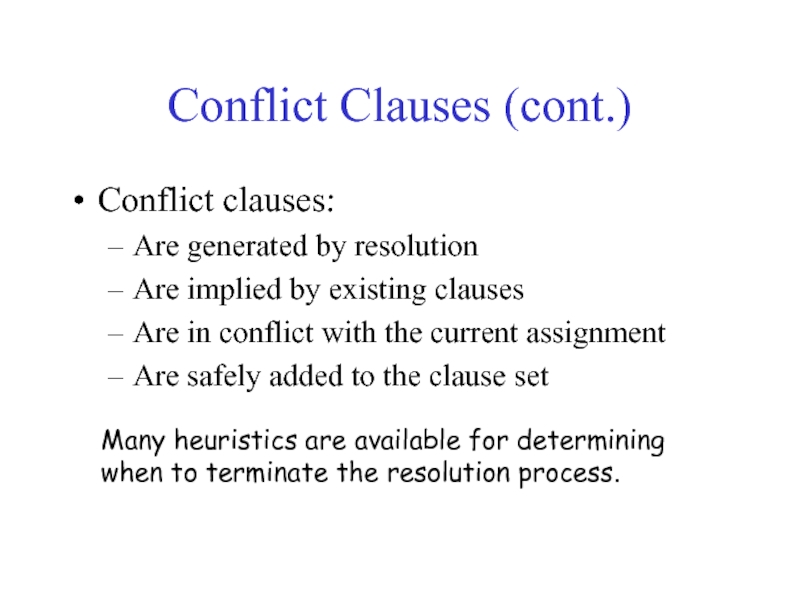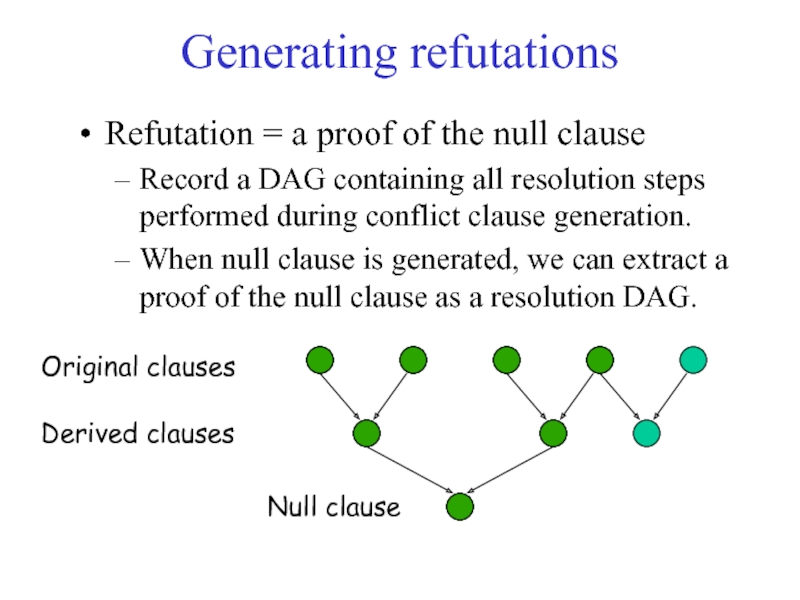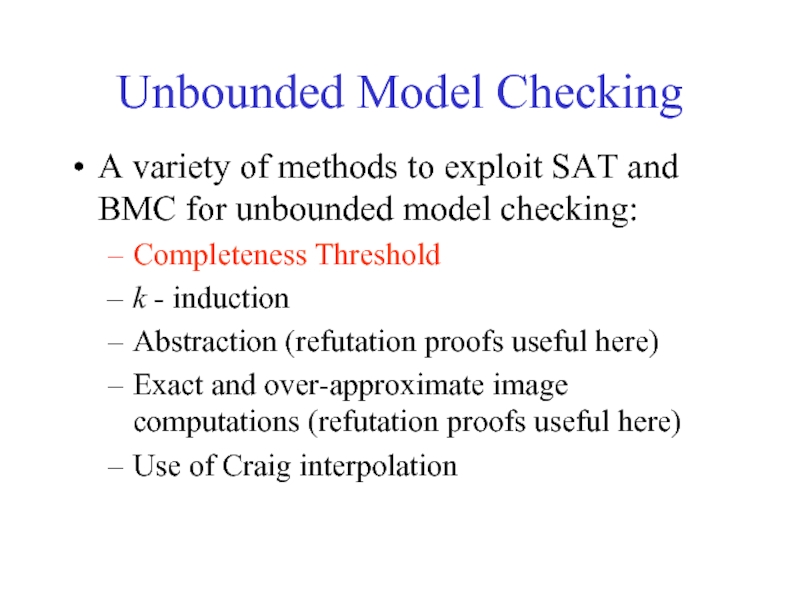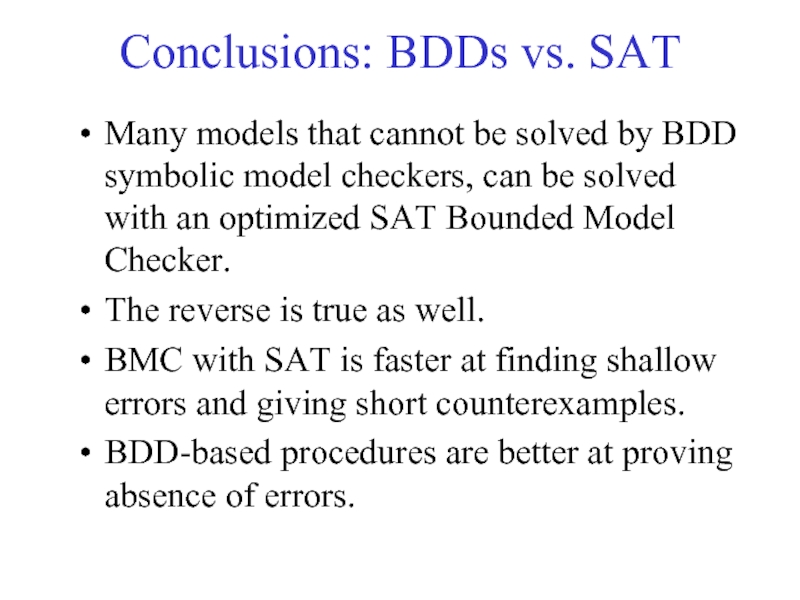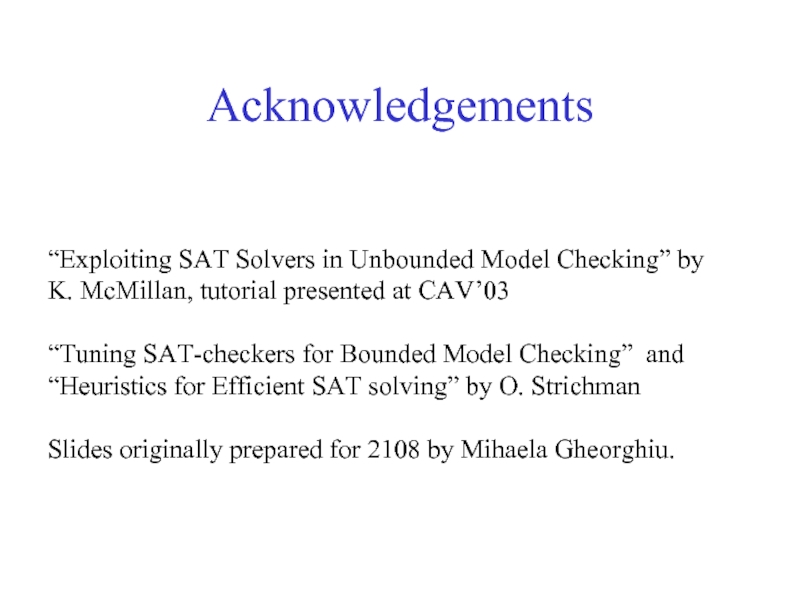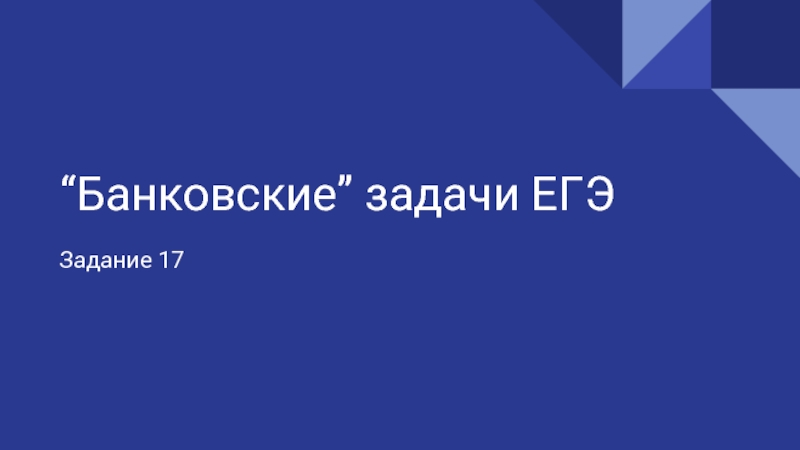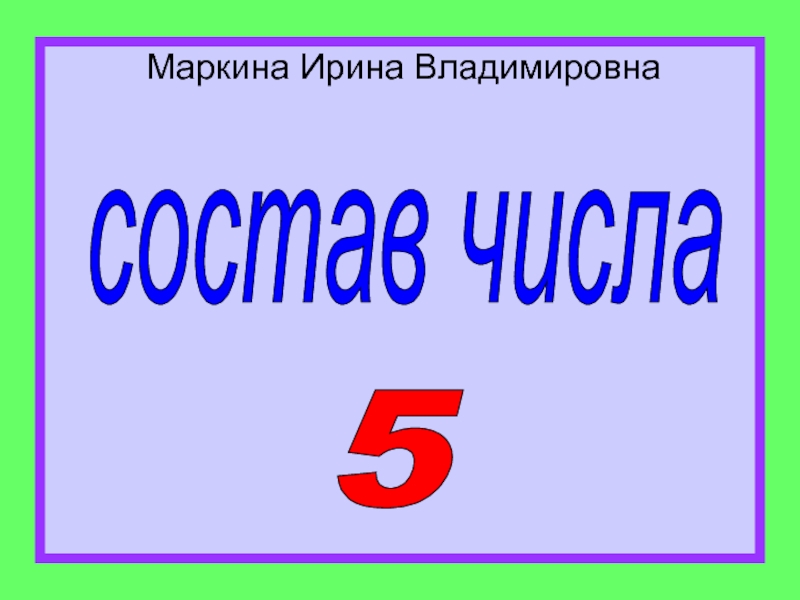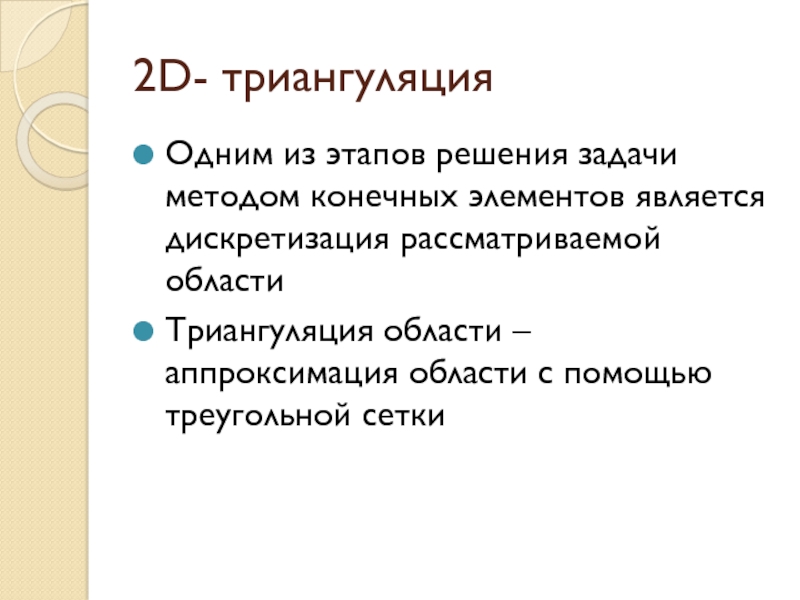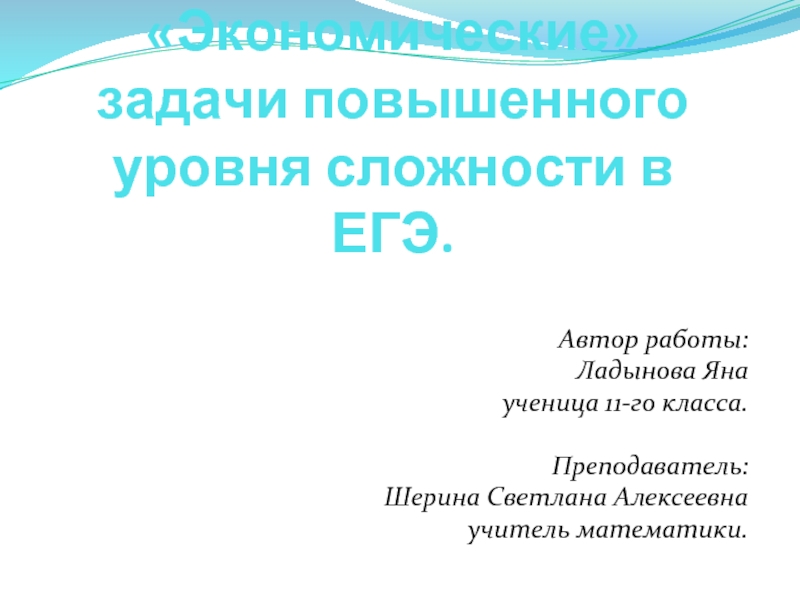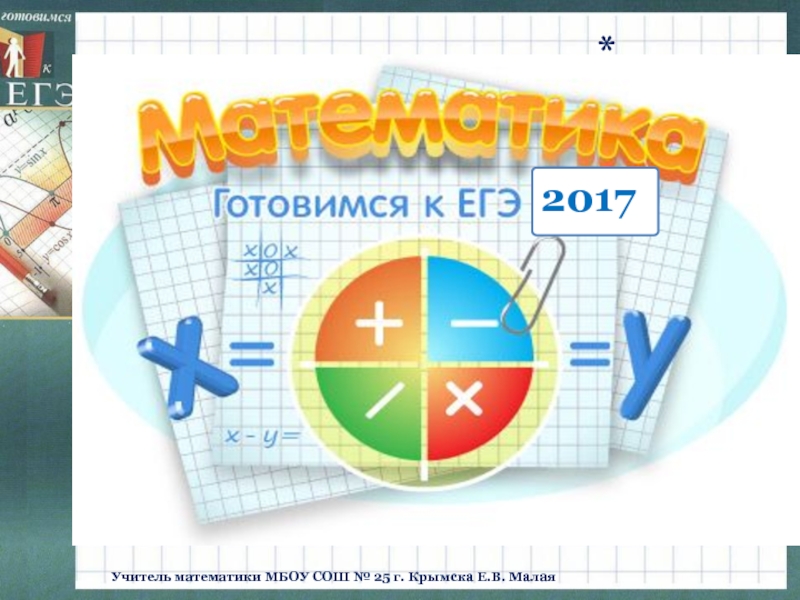- Главная
- Разное
- Дизайн
- Бизнес и предпринимательство
- Аналитика
- Образование
- Развлечения
- Красота и здоровье
- Финансы
- Государство
- Путешествия
- Спорт
- Недвижимость
- Армия
- Графика
- Культурология
- Еда и кулинария
- Лингвистика
- Английский язык
- Астрономия
- Алгебра
- Биология
- География
- Детские презентации
- Информатика
- История
- Литература
- Маркетинг
- Математика
- Медицина
- Менеджмент
- Музыка
- МХК
- Немецкий язык
- ОБЖ
- Обществознание
- Окружающий мир
- Педагогика
- Русский язык
- Технология
- Физика
- Философия
- Химия
- Шаблоны, картинки для презентаций
- Экология
- Экономика
- Юриспруденция
SAT and model checking презентация
Содержание
- 1. SAT and model checking
- 2. Bounded Model Checking (BMC) A.I. Planning problems:
- 3. What is SAT? SATisfying assignment! Given a
- 4. BMC idea Given: transition system
- 5. BMC idea (cont’d) AG p means p
- 6. Safety-checking as BMC p is
- 7. Example: a two bit counter Safety property:
- 8. Example: another counter
- 9. What BMC with SAT Can Do All
- 10. How big should k be? For every
- 11. How big should k be? Diameter d
- 12. How big should k be? Theorem: for Gp properties CT = d
- 13. How big should k be? Theorem: for
- 14. Given ϕ in CNF: (x,y,z),(-x,y),(-y,z),(-x,-y,-z) Decide()
- 15. While (true) { if (!Decide()) return (SAT);
- 16. A = ∅ empty clause? y
- 17. The Implication Graph (¬a ∨ b)
- 18. Resolution a ∨ b ∨ ¬c ¬a
- 19. Conflict clauses (¬a ∨ b) ∧
- 20. Conflict Clauses (cont.) Conflict clauses: Are generated
- 21. Generating refutations Refutation = a proof of
- 22. Unbounded Model Checking A variety of methods
- 23. Conclusions: BDDs vs. SAT Many models that
- 24. Acknowledgements “Exploiting SAT Solvers in Unbounded
Слайд 2Bounded Model Checking (BMC)
A.I. Planning problems: can we reach a desired
Verification of safety properties: can we find a bad state in k steps?
Verification: can we find a counterexample in k steps ?
Biere, Cimatti, Clarke, Zhu, 1999
Слайд 3What is SAT?
SATisfying assignment!
Given a propositional formula in CNF, find if
ω1 = (b c)
ω2 = (¬a ¬d)
ω3 = (¬b d)
ϕ = ω1 ω2 ω3
A = {a=0, b=1, c=0, d=1}
clauses
literals
Слайд 4BMC idea
Given: transition system M, temporal logic formula f, and
Construct propositional formula Ω(k) that is satisfiable iff f is valid
along a path of length k
Path of length k:
Say f = EF p and k = 2, then
What if f = AG p ?
Слайд 5BMC idea (cont’d)
AG p means p must hold in every state
We take
So
That means we look for counterexamples
Слайд 6Safety-checking as BMC
p is preserved up to k-th transition iff
If satisfiable, satisfying assignment gives counterexample to the
safety property.
Слайд 7Example: a two bit counter
Safety property: AG
Ω(2) is unsatisfiable. Ω(3)
Initial state:
Transition:
Слайд 8Example: another counter
Liveness property: AF
Ω(2) is
Check: EG
where
Satisfying assignment gives counterexample to the liveness property
Слайд 9What BMC with SAT Can Do
All LTL
ACTL and ECTL
In principle, all
efficient universal quantifier elimination or fixpoint computation is an active area of research
Слайд 10How big should k be?
For every model M and LTL property
The minimal such k is the Completeness Threshold (CT)
Слайд 11How big should k be?
Diameter d = longest shortest path from
Recurrence Diameter rd = longest loop-free path.
rd ¸ d
rd = 3
Слайд 13How big should k be?
Theorem: for Fp properties CT= rd
Open Problem:
Слайд 14Given ϕ in CNF: (x,y,z),(-x,y),(-y,z),(-x,-y,-z)
Decide()
Deduce()
Resolve_Conflict()
√
X
X
X
X
X
ϕ
A basic SAT solver
Слайд 15While (true)
{
if (!Decide()) return (SAT);
while (!Deduce())
if (!Resolve_Conflict()) return (UNSAT);
}
Choose the
variable and value.
Return False if all
variables are assigned
Apply unit clause rule.
Return False if reached
a conflict
Backtrack until
no conflict.
Return False if impossible
Basic Algorithm
Слайд 16A = ∅
empty
clause?
y
UNSAT
conflict?
Obtain conflict
clause and
backtrack
y
n
is A
total?
y
SAT
Branch:
add some literal
to A
DPLL-style SAT
SATO,GRASP,CHAFF,BERKMIN
n
Слайд 18Resolution
a ∨ b ∨ ¬c
¬a ∨ ¬c ∨ d
b ∨ ¬c
When a conflict occurs, the implication graph is
used to guide the resolution of clauses, so that the
same conflict will not occur again.
Слайд 20Conflict Clauses (cont.)
Conflict clauses:
Are generated by resolution
Are implied by existing clauses
Are
Are safely added to the clause set
Many heuristics are available for determining
when to terminate the resolution process.
Слайд 21Generating refutations
Refutation = a proof of the null clause
Record a DAG
When null clause is generated, we can extract a proof of the null clause as a resolution DAG.
Original clauses
Derived clauses
Null clause
Слайд 22Unbounded Model Checking
A variety of methods to exploit SAT and BMC
Completeness Threshold
k - induction
Abstraction (refutation proofs useful here)
Exact and over-approximate image computations (refutation proofs useful here)
Use of Craig interpolation
Слайд 23Conclusions: BDDs vs. SAT
Many models that cannot be solved by BDD
The reverse is true as well.
BMC with SAT is faster at finding shallow errors and giving short counterexamples.
BDD-based procedures are better at proving absence of errors.
Слайд 24Acknowledgements
“Exploiting SAT Solvers in Unbounded Model Checking” by
K. McMillan, tutorial
“Tuning SAT-checkers for Bounded Model Checking” and
“Heuristics for Efficient SAT solving” by O. Strichman
Slides originally prepared for 2108 by Mihaela Gheorghiu.
